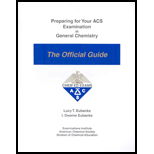
Interpretation:
The vapor pressure of solution with the benzene to octane molar ratio of
Concept Introduction:
According to Raoult’s law, partial pressure of each component of an ideal mixture is determined by multiplication of vapor pressure of its pure component and its mole fraction in solution.
Mathematical expression for Raoult’s law is as follows:
Here,
Raoult’s law also states that total vapor pressure of solution is calculated by sum of partial pressures of both components.
The expression for total pressure of solution is as follows:
Here,
Answer to Problem 6PQ
Option (B) is the correct one.
Explanation of Solution
Reason for correct option:
Since molar ratio of benzene to octane is
Total number of moles can be calculated as follows:
Substitute
The formula to calculate mole fraction of component is as follows:
Substitute
Substitute
Substitute 0.667 for
Substitute 0.333 for
Given solution is mixture of benzene and octane. Therefore equation (2) modifies as follows:
Here,
Substitute
Hence option (B) is correct.
Reason for incorrect option:
Vapor pressure of given solution comes out to be
The vapor pressure of solution with benzene to octane molar ratio of
Want to see more full solutions like this?
Chapter SM Solutions
Preparing for your ACS examination in general chemistry
 ChemistryChemistryISBN:9781305957404Author:Steven S. Zumdahl, Susan A. Zumdahl, Donald J. DeCostePublisher:Cengage Learning
ChemistryChemistryISBN:9781305957404Author:Steven S. Zumdahl, Susan A. Zumdahl, Donald J. DeCostePublisher:Cengage Learning ChemistryChemistryISBN:9781259911156Author:Raymond Chang Dr., Jason Overby ProfessorPublisher:McGraw-Hill Education
ChemistryChemistryISBN:9781259911156Author:Raymond Chang Dr., Jason Overby ProfessorPublisher:McGraw-Hill Education Principles of Instrumental AnalysisChemistryISBN:9781305577213Author:Douglas A. Skoog, F. James Holler, Stanley R. CrouchPublisher:Cengage Learning
Principles of Instrumental AnalysisChemistryISBN:9781305577213Author:Douglas A. Skoog, F. James Holler, Stanley R. CrouchPublisher:Cengage Learning Organic ChemistryChemistryISBN:9780078021558Author:Janice Gorzynski Smith Dr.Publisher:McGraw-Hill Education
Organic ChemistryChemistryISBN:9780078021558Author:Janice Gorzynski Smith Dr.Publisher:McGraw-Hill Education Chemistry: Principles and ReactionsChemistryISBN:9781305079373Author:William L. Masterton, Cecile N. HurleyPublisher:Cengage Learning
Chemistry: Principles and ReactionsChemistryISBN:9781305079373Author:William L. Masterton, Cecile N. HurleyPublisher:Cengage Learning Elementary Principles of Chemical Processes, Bind...ChemistryISBN:9781118431221Author:Richard M. Felder, Ronald W. Rousseau, Lisa G. BullardPublisher:WILEY
Elementary Principles of Chemical Processes, Bind...ChemistryISBN:9781118431221Author:Richard M. Felder, Ronald W. Rousseau, Lisa G. BullardPublisher:WILEY





